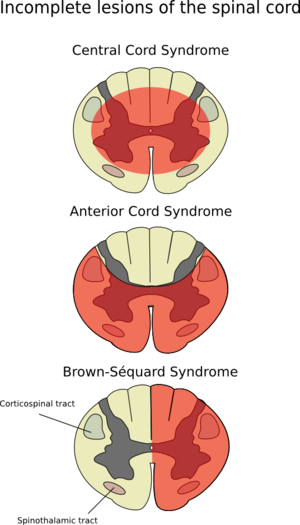Anterior Cord Syndrome: Difference between revisions
(Created page with "Introduction") |
(Added Introduction, Added Headings) |
||
| Line 1: | Line 1: | ||
Introduction | == Introduction == | ||
[[File:Incomplete Spinal Cord Injury.png|thumb]] | |||
Anterior cord syndrome referred to as Anterior spinal artery syndrome (ASAS) or ventral cord syndrome(VCS)<ref>Santana JA, Dalal K. Ventral Cord Syndrome. 2021 Aug 26. In: StatPearls [Internet]. Treasure Island (FL): StatPearls Publishing; 2021 Jan–.</ref>. ASAS is an incomplete [[Spinal Cord Injury|spinal cord injury]](SCI) that is often related to flexion injuries of the cervical region that result in infarction of the ventral two thirds of the cord and/or its vascular supply from the anterior spinal artery.Patients present with impairments of both pain and temperature sensation while the vibration and proprioception sensation is preserved. Motor deficits are observable both at and below the level of injury. | |||
== Clinically Relevant Anatomy == | |||
ASAS is caused by ischemia within the anterior spinal artery (ASA), which supplies blood to the anterior 2/3of the spinal cord. The ASA forms from the bilateral vertebral arteries at the foramen magnum. It runs as an uninterrupted artery within the anterior median sulcus of the spinal cord to the conus medullaris. Radicular arteries enter the spinal canal through the intervertebral foramen and primarily supply the nerve roots; however, some also anastomose and contribute to the ASA. The largest of these radicular arteries is the artery of Adamkiewicz, which most commonly arises off of a left intercostal artery between T9-T12 but can vary anatomically. The ASA gives off small sulcal and penetrating arteries that enter the body of the spinal cord to supply blood. | |||
The anterior spinal artery supplies blood to the bilateral anterior and lateral horns of the spinal cord, as well as the bilateral [[spinothalamic tract]]<nowiki/>s and [[Corticospinal Tract|corticospinal tracts]]. The anterior horns and corticospinal tracts control the somatic motor system from the neck to the feet. The lateral horns span T1-L2 of the spinal cord and house the neuronal cell bodies of the sympathetic nervous system. The spinothalamic tracts relay pain and temperature sensory information. The anterior spinal artery, with a few radicular artery contributions, is the sole source of blood supply to these areas of the spinal cord via its sulcal and penetrating arteries. | |||
== Epidemiology == | |||
== Mechanism of Injury == | |||
== Pathological process == | |||
== Clinical Presentation == | |||
== Diagnostic Procedures == | |||
== Outcome Measures == | |||
== Management/Interventions == | |||
=== Non-surgical === | |||
=== Surgical === | |||
== Prognosis == | |||
== Differential Diagnosis == | |||
* [[Central Cord Syndrome|Central cord syndrome]] | |||
* Dorsal cord syndrome | |||
* Brown-Séquard syndrome | |||
* Conus medullaris syndrome | |||
* [[Cauda Equina Syndrome|Cauda equina syndrome]] | |||
* Transverse myelitis | |||
* Guillain-Barré syndrome | |||
* Multiple sclerosis | |||
* Spinal epidural abscess | |||
* Epidural hematoma | |||
* Disk herniation | |||
* Spinal cord neoplasm | |||
* Meningitis/encephalitis | |||
Revision as of 18:31, 30 December 2021
Introduction[edit | edit source]
Anterior cord syndrome referred to as Anterior spinal artery syndrome (ASAS) or ventral cord syndrome(VCS)[1]. ASAS is an incomplete spinal cord injury(SCI) that is often related to flexion injuries of the cervical region that result in infarction of the ventral two thirds of the cord and/or its vascular supply from the anterior spinal artery.Patients present with impairments of both pain and temperature sensation while the vibration and proprioception sensation is preserved. Motor deficits are observable both at and below the level of injury.
Clinically Relevant Anatomy[edit | edit source]
ASAS is caused by ischemia within the anterior spinal artery (ASA), which supplies blood to the anterior 2/3of the spinal cord. The ASA forms from the bilateral vertebral arteries at the foramen magnum. It runs as an uninterrupted artery within the anterior median sulcus of the spinal cord to the conus medullaris. Radicular arteries enter the spinal canal through the intervertebral foramen and primarily supply the nerve roots; however, some also anastomose and contribute to the ASA. The largest of these radicular arteries is the artery of Adamkiewicz, which most commonly arises off of a left intercostal artery between T9-T12 but can vary anatomically. The ASA gives off small sulcal and penetrating arteries that enter the body of the spinal cord to supply blood.
The anterior spinal artery supplies blood to the bilateral anterior and lateral horns of the spinal cord, as well as the bilateral spinothalamic tracts and corticospinal tracts. The anterior horns and corticospinal tracts control the somatic motor system from the neck to the feet. The lateral horns span T1-L2 of the spinal cord and house the neuronal cell bodies of the sympathetic nervous system. The spinothalamic tracts relay pain and temperature sensory information. The anterior spinal artery, with a few radicular artery contributions, is the sole source of blood supply to these areas of the spinal cord via its sulcal and penetrating arteries.
Epidemiology[edit | edit source]
Mechanism of Injury[edit | edit source]
Pathological process[edit | edit source]
Clinical Presentation[edit | edit source]
Diagnostic Procedures[edit | edit source]
Outcome Measures[edit | edit source]
Management/Interventions[edit | edit source]
Non-surgical[edit | edit source]
Surgical[edit | edit source]
Prognosis[edit | edit source]
Differential Diagnosis[edit | edit source]
- Central cord syndrome
- Dorsal cord syndrome
- Brown-Séquard syndrome
- Conus medullaris syndrome
- Cauda equina syndrome
- Transverse myelitis
- Guillain-Barré syndrome
- Multiple sclerosis
- Spinal epidural abscess
- Epidural hematoma
- Disk herniation
- Spinal cord neoplasm
- Meningitis/encephalitis
- ↑ Santana JA, Dalal K. Ventral Cord Syndrome. 2021 Aug 26. In: StatPearls [Internet]. Treasure Island (FL): StatPearls Publishing; 2021 Jan–.







